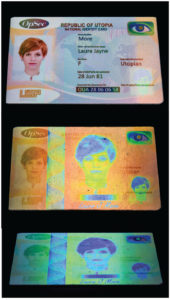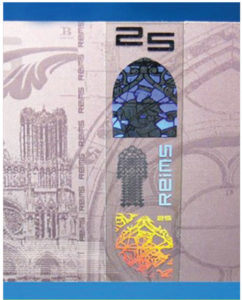
Submitted by Andy Bruce
on behalf of the International Hologram Manufacturers Association
In the face of continued reports about fake identity documents and the ‘skills’ of counterfeiters to reproduce passports, driving licenses and other official papers that look like the real thing to the untrained eye, Dr. Paul Dunn, chairman of the International Hologram Manufacturers Association (IHMA), considers the latest developments in security and authentication holography.
There can be little doubt that the illicit production of counterfeit and fake ID documents is big business. Around the world, the combined cost of fraudulent passports, drivers’ licenses and pass cards adds up to billions of dollars a year in lost revenues. It also impacts on corporate reputations, share values and issues around product efficacy and safety. Meanwhile, the cost of paying for anti-counterfeiting measures and teams tasked with bringing the criminals to justice can run into the millions of dollars.
We continue to see the impact of identity theft on a truly global scale. There have been recent reports from China about more than a million fake identity documents seized, followed by dozens of people arrested by Chinese police after an investigation into a counterfeit gang operating across 20 provinces. Elsewhere, millions of people are falling victim to identity theft – in the last few years, identity thieves have stolen over $107 billion in the US, according to a 2017 Identity Fraud Study.
In the UK, a national newspaper report highlighted a disturbing case involving criminals providing illegal immigrants with fake passports and documents to land jobs caring for the vulnerable. Australia is so awash with fake drivers licenses, passports and other IDs that the Commonwealth Department of Home Affairs has introduced a document verification service (DVS) to check that various government-issued documents, which also include visas and birth certificates, are indeed legitimate.
Also, modern reprographic technologies make it possible to copy many things, but the real issue is just how accurately can holograms be copied? The answer is that their intrinsic features ensure that the techniques and visual effects make it extremely difficult, perhaps almost impossible, to copy a well-designed security hologram 100%.
But in the fight against fake IDs, holography continues on the front line, where its value in securing data and protecting against criminal interference, tampering, alteration, forgery or imitation is priceless – new technology, innovation and advanced processes ensure protection against the forgery of variable information (photographs and personal data).
Holographic technology offers a means of protection and authentication, and a warning about the dangers of counterfeiting. Therefore, they are not solely to prevent counterfeits but perform the role of an effective detection device, making it easier for the trained eye to distinguish the genuine item from the fake.
Manufacturers are responding to the technical challenges this imposes, and in recent times, we have seen significant growth in the number of passports and other documents issued which feature OVDs (Optically Variable Devices) to stay at the forefront of overt asset and brand protection programs. The OVD can be used as a standalone feature or combined with printed security features to create devices that are extremely difficult to replicate using conventional photocopy or scanning technologies.
Indeed, data from a leading manufacturer of products for ID and secure document production, personalization, verification and protection – ITW – says that when it comes to passports and ID cards, 81% of them feature holograms, according to an estimate that spans the 2010 to 2016 period. That compares to 69% for the period from 2000 through 2009. By the end of 2016, 89% of passports had holograms (compared to 60% in 2006).
New generation
 There’s a new generation of high-security innovative holograms emerging, which is driving improvements in ID document security and protection, helping those with responsibility for law enforcement stay ahead of the criminals.
There’s a new generation of high-security innovative holograms emerging, which is driving improvements in ID document security and protection, helping those with responsibility for law enforcement stay ahead of the criminals.
These include Surys’ Spectreod, which scooped the Innovation in Holographic Technology category at the Excellence in Holography Awards 2018 for its advanced utilization of phase-shifting micro-optic authentication elements. These enable the viewer to pick out and identify information using a smartphone light source. When observed at a direct angle, Spectreod is recognizable to the naked eye, but when it comes under a light source, pre-selected floating colored information appears that follows the movement of the light. This can help to confirm the authenticity of a document at a glance.
The company also has continued to further expand its diffractive identity device (DID) technology platform with a portfolio of products for identity applications, including its latest DID Wave and DID Virtual products.
Another pushing the boundaries is the Singapore University of Technology and Design, which has developed a new holographic security device that shows as a color image when viewed in white light but reveals up to three different hidden holographic projections under red, green and blue laser illumination. It’s believed to be the first time that holograms have been encrypted into a color print for enhanced optical security applications across a wide spectrum of ID document security applications.
Offering a high level of counterfeit resistance, a new generation of optical features – which incorporate holographic effects and offer overt, covert and forensic features – will herald a step-change in the secure document industry over the next few years. OpSec Security is in the vanguard with proprietary Advanced Colour Control (ACC) technology that can be changed by wavelengths/intensities of light, altering the liquid crystal molecules and the color they reflect.
Zhongchao Special Security Technology’s ColorSpace is a new micro-optic feature that utilizes holographic micro-nanostructures to provide colorful 3D dynamic graphic features with full parallax. The colors are fixed and can be precisely controlled at the nanometer level and also are easy to observe and describe. ColorSpace is ultra-thin (less than 30 microns), enabling it to be easily integrated into security threads, foil stripes, labels and ID applications.
Promoted as a significant step forward in moving further than the current state-of-the-art in light transmission, optically variable colored effects are visible through Surys’ metallic foil Plasmogram: a new-generation, high-security DOVID that combines reflective and see-through effects on a nano-structured film incorporating physical properties. It’s one of several “break through” technologies that now are available for the high-security ID sector.
For instance, we are seeing optical security features coming through that can be integrated with almost any substrates – plastic cards, polycarbonate material, composite and paper – to deliver “smart” ID solutions, which combine optical and digital technologies to offer both visual and automatic authentication based around the interactions of the user and smart devices.
Companies at the forefront of these developments include OVD Kinegram with digital seal. The technology integrates digital ID with the physical document in a secure manner in an innovative way, which takes the biographical data found in the optical character recognition (OCR) line from an identity document and encodes the information into a quick response (QR) code that can be easily and quickly read using a smartphone. The QR code can be encrypted if required and is protected against counterfeiting or manipulation using a Kinegram optical structure. The information is read using an intelligent smartphone app that does not require any special add on. Surys also has developed its Optical Smart technologies that combine a digital data matrix code with a high-definition micro image, which is part of the holographic security design. Using a dedicated app, specific images and properties can be authenticated without the need for an Internet connection.
Future challenges

Looking to the future, while holography undoubtedly faces challenges as ID technology and associated criminal behavior continue to evolve, if it remains focused on its role as an effective, flexible and reliable anti-counterfeiting measure, then its position among governments and those responsible for law enforcement will be assured. It will continue to play an important part in moving ID documents to the next stage of development, ensuring quality and checking the trade in fake IDs while those documents not displaying security holograms are seized and destroyed.
Those involved in law enforcement, border protection and ID security will benefit from the presence of holography technologies and devices on passports and other documents, clearly seeing and benefiting from the advantages they provide.
The technology may have been around for decades, but holograms for secure authentication still are standing strong as an effective document security feature. Moreover, the use of well-designed and properly deployed authentication solutions, as advocated by the ISO 12931 standard, enables those with ID protection responsibilities to verify the authenticity of a legitimate product, differentiating it from counterfeits.
Even those that carry a “fake” authentication feature can be distinguished from the genuine item if that item carries a carefully thought-out authentication solution. And, it would appear that the advantages holography offers will continue even as digital and mobile ID technologies gain increasing traction.
The IHMA is made up of almost 100 of the world’s leading hologram companies. Members include the leading producers and converters of holograms for banknote security, anti-counterfeiting, brand protection, packaging, graphics and other commercial applications around the world, and actively cooperate to maintain the highest professional, security and quality standards. To learn more, visit www.ihma.org.


